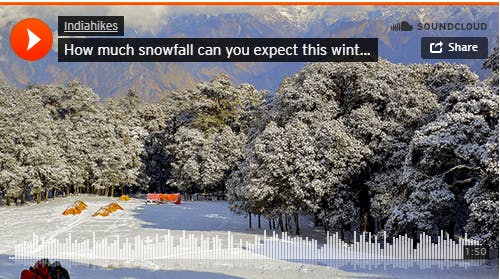How Much Snowfall Can You Expect In The Himalayas This Winter?
Share this story
How Much Snowfall Can You Expect In The Himalayas This Winter?
Category News
By Swathi Chatrapathy
2017-09-18
Last year, when our trekkers set out on winter treks, many of them came back disappointed. It was as late as December 20th and they had not seen snow. The first winter snow, which usually comes down by mid-December, took until December 25th to show up.
It was the El Nino year last year and the year before last. To put it crudely, El Nino is a climatic pattern resulting from a change in atmospheric temperature in the Pacific Ocean. That’s very crude, but there are many websites that have detailed reports on El Nino. Our concern is more with how it affects our winter treks.
So in this week’s episode of Trek Talks With Vishnu Benne, Vishnu talks about how this year’s snow pattern is going to be. Is going to be the same as last year or is it going to come in earlier this year?
Listen to find out.
How did El Nino affect the Indian Himalayas?
It’s hard to believe that a small change in the pattern of air circulation deep in the Pacific Ocean could cause such a drastic change in climate all the way in India.
Because of El Nino, there was less rainfall and also less snowfall. Snow in the Himalayas came in late and disappeared early too.
Our summer treks like Pangarchulla, which climb up to 15,000 ft and normally have snow till the end of May, saw snow melting by mid-May, leaving tough boulder sections exposed.
On the other hand, snow came in very late on our winter treks. Waiting for the first snowfall was most excruciating with trekkers calling every day to find out if they would see snow. It finally came down on December 25th amidst Christmas celebrations.
But overall, the whole year was dry with streams drying up and the earth looking parched.
The year of La Nina
This year, however, is the year of La Nina. As opposed to El Nino, which is sometimes called the warm phase, La Nina is another climatic pattern also referred to as the cold phase.
You’ll notice that there has been more rainfall this year than last year all over India. Our August treks didn’t see a day without rainfall.
That’s a promising sign. It lends us to believe that there will be an earlier winter this year with more snow than last year.
In fact, it has already started snowing on our high mountain passes like Pin Bhaba (16,100 ft). This isn’t winter snow. It is September snow that comes down irregularly and melts away quickly. But it is a weather pattern we have observed for years. It is a welcome sign of normalcy.
This means you should expect to see snow from around mid-December on all our winter treks. Any treks that hit the 10,000 ft mark in Uttarakhand are likely to put on their yearly blanket of snow around this time. That is Kuari Pass, Kedarkantha, Dayara Bugyal, Deoriatal, Brahmatal and Har Ki Dun.
So it looks to be a snowy winter! Make sure you are geared up well!
Sign up for our much loved Weekly Mailer
We have terrific trekking tips, trek updates and trek talks to look forward to

